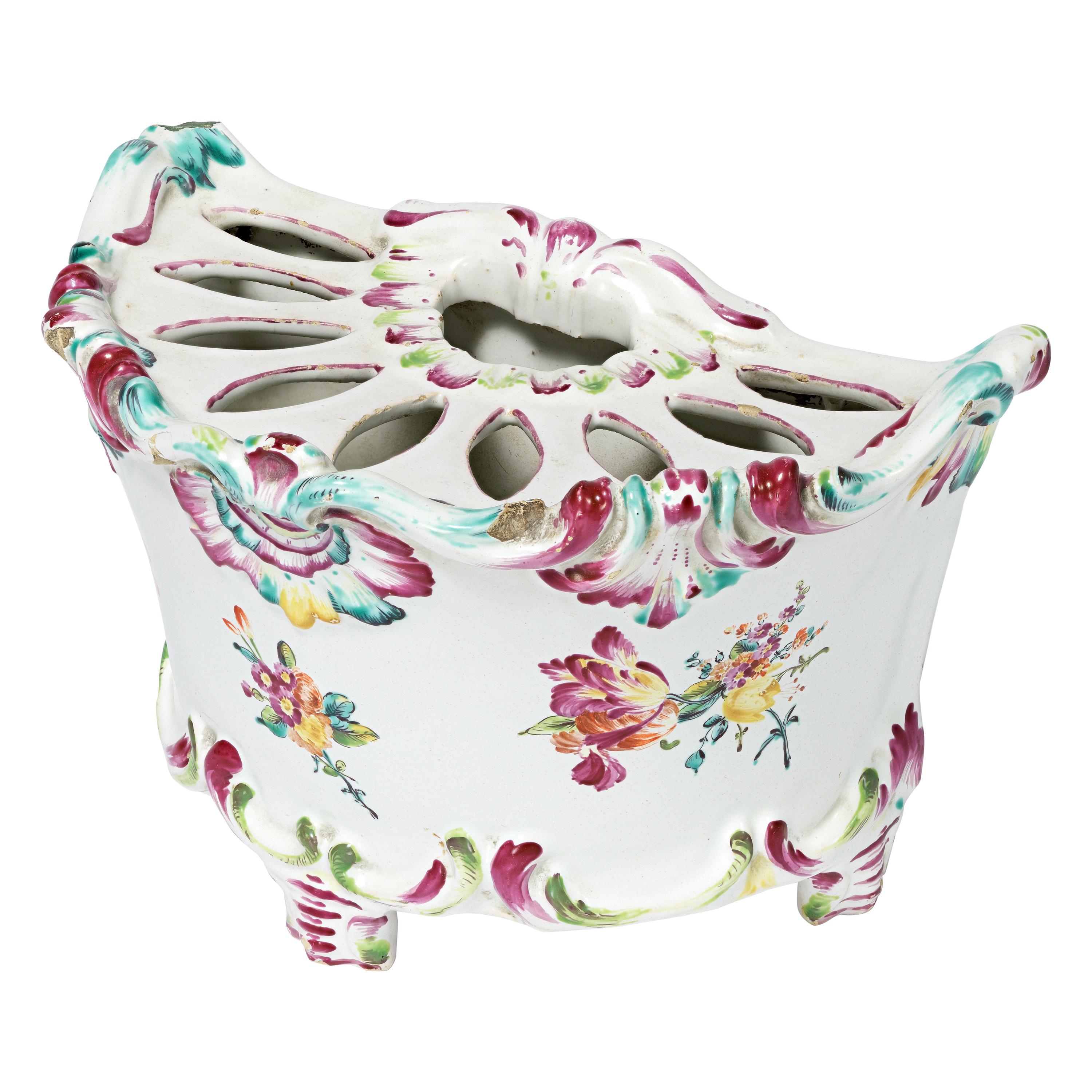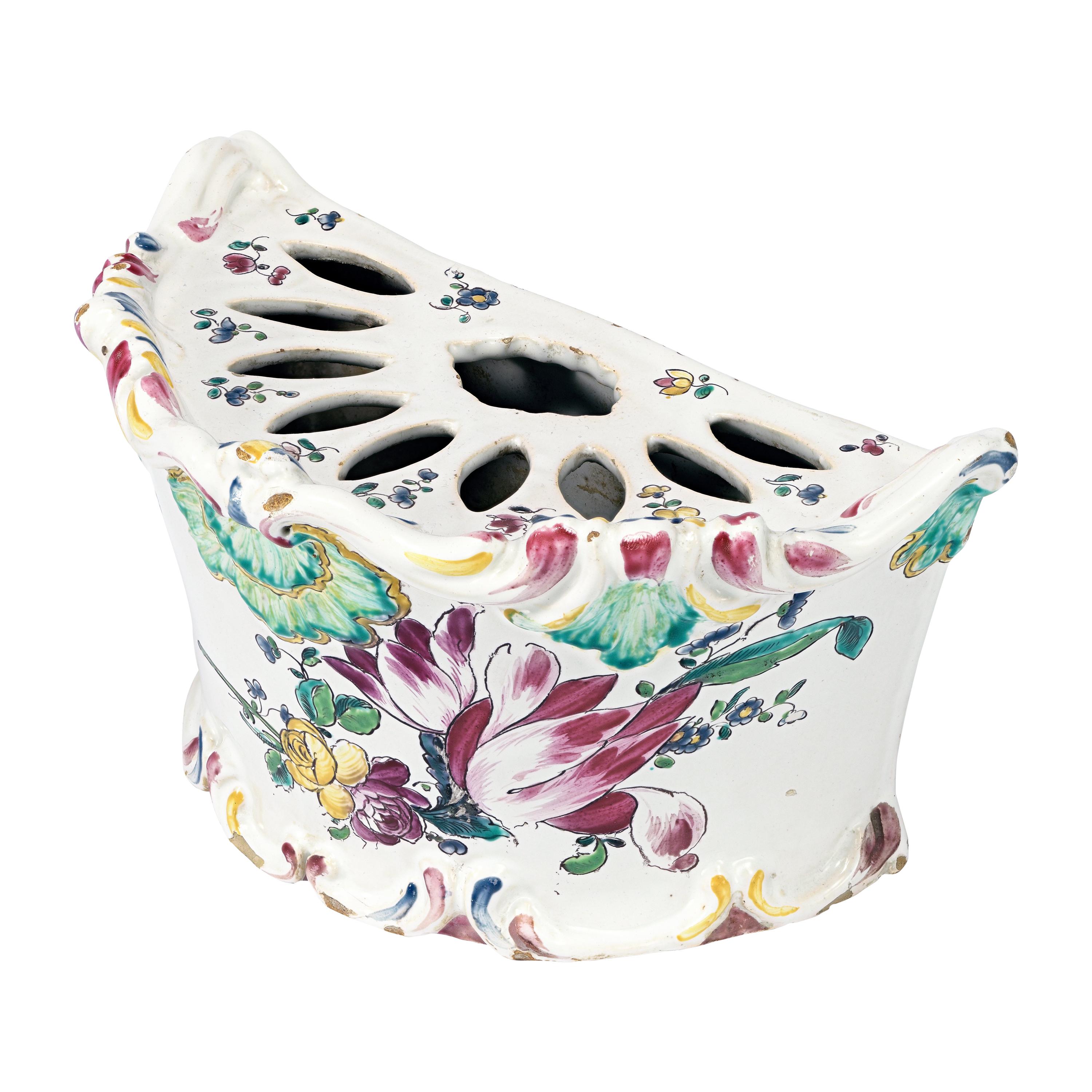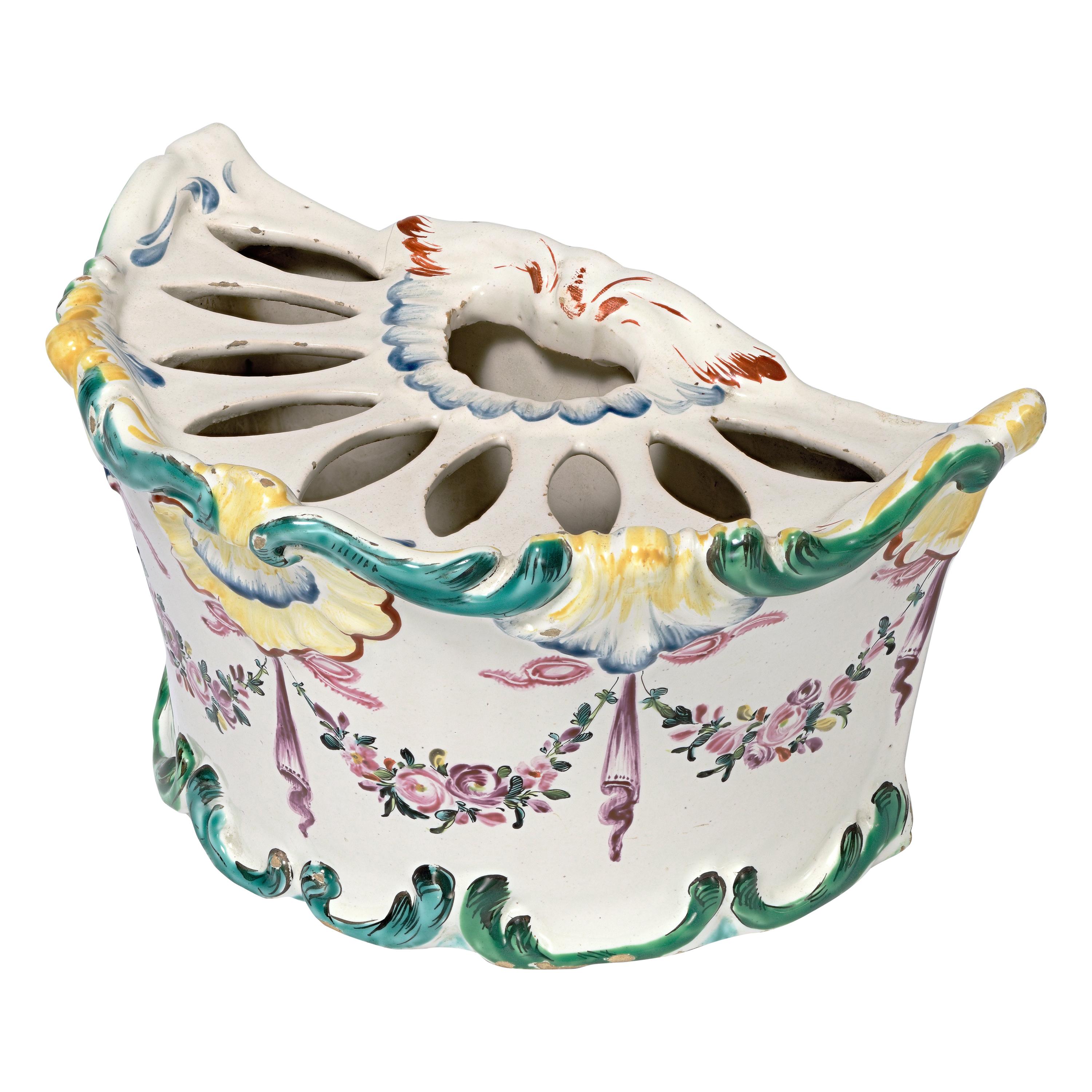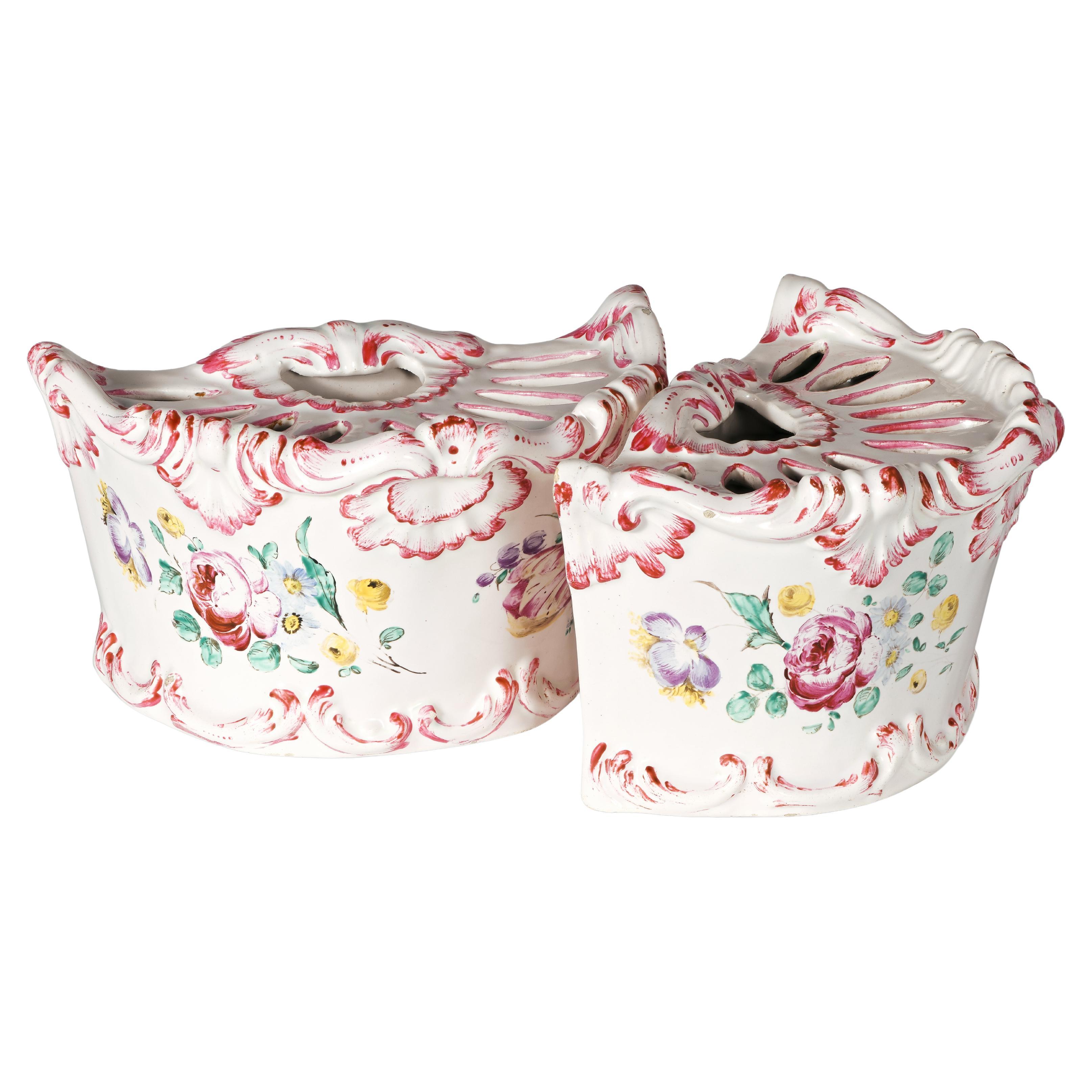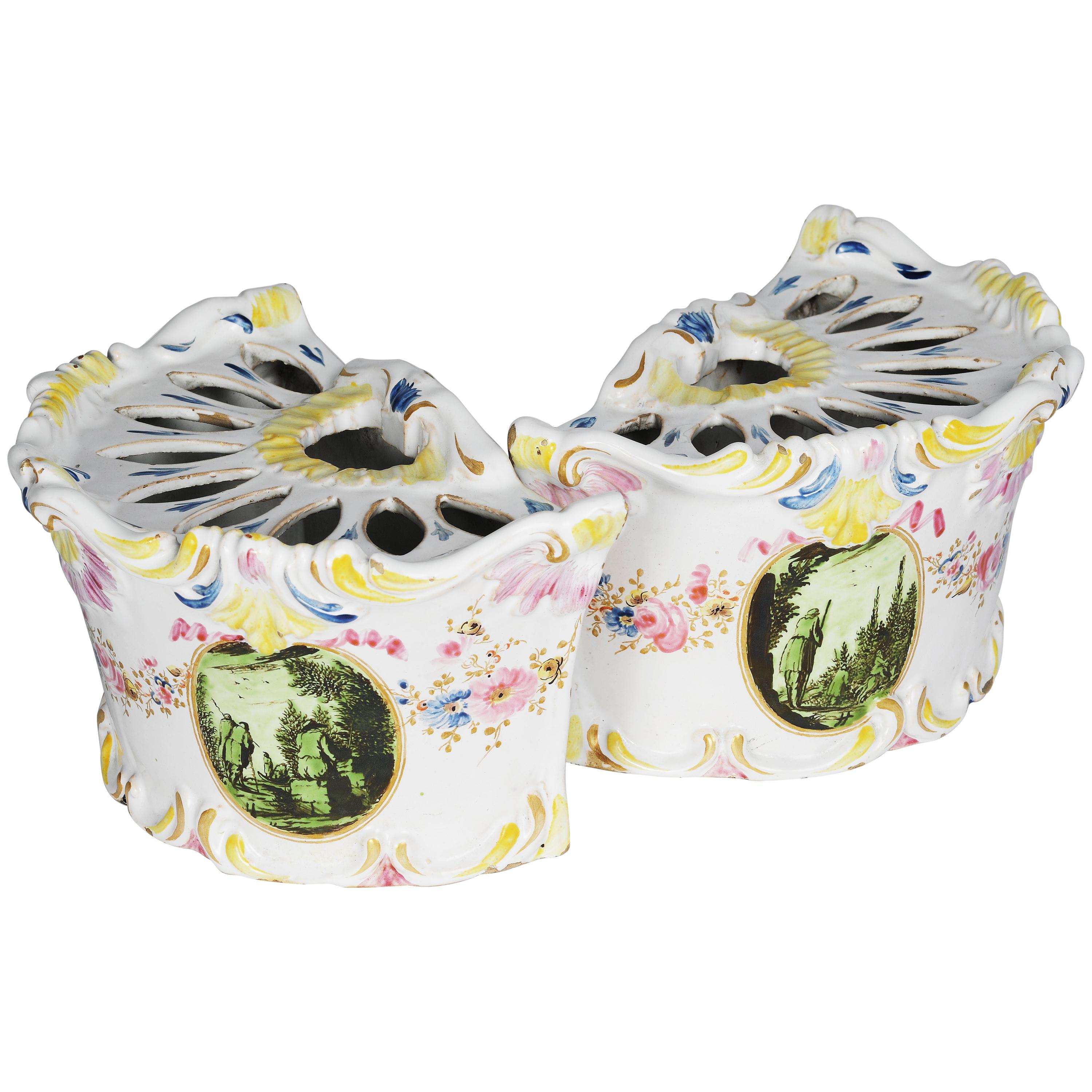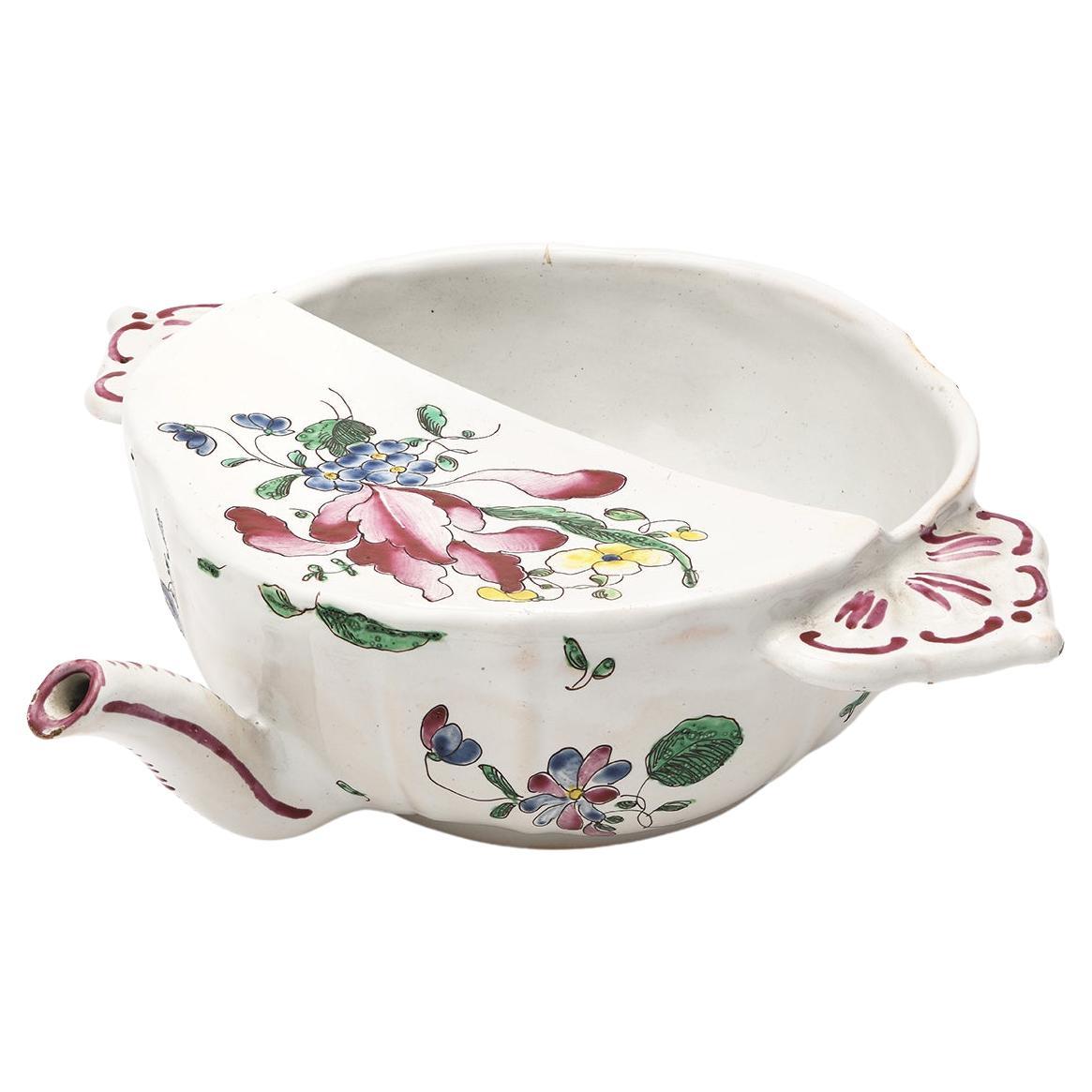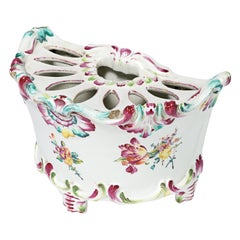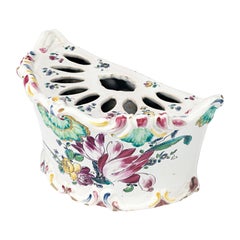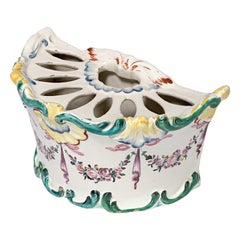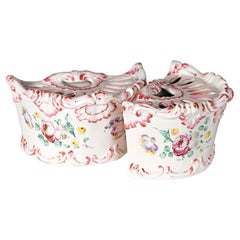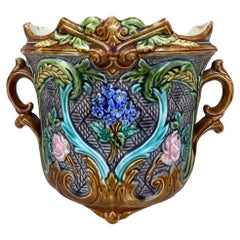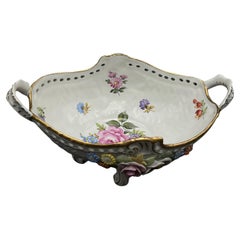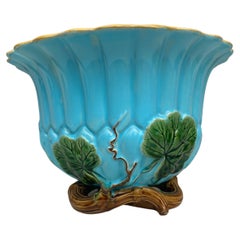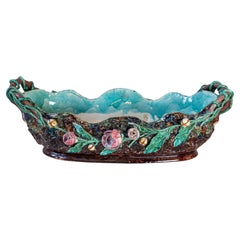Items Similar to Maiolica flower pot "a mezzaluna," Pasquale Rubati Factory, Milan, circa 1770
Video Loading
Want more images or videos?
Request additional images or videos from the seller
1 of 22
Maiolica flower pot "a mezzaluna," Pasquale Rubati Factory, Milan, circa 1770
$3,354.80
£2,496.97
€2,800
CA$4,595.24
A$5,110.91
CHF 2,668.76
MX$62,194.34
NOK 34,084.12
SEK 31,964.89
DKK 21,315.42
Shipping
Retrieving quote...The 1stDibs Promise:
Authenticity Guarantee,
Money-Back Guarantee,
24-Hour Cancellation
About the Item
Majolica flower pot "crescent" decorated in manganese
Pasquale Rubati Factory
Milan, c. 1770
4.92 in x 8.66 in x 5,31 in
12.5 cm x 22 cm X 13.5 cm
Weight: 2.29 lb (1039 g)
State of conservation: intact with slight chipping due to use in relief parts
A rare example of a flower pot "a mezzaluna" produced by the manufactory of the refined painter Pasquale Rubati, who opened a factory in Milan in 1756 to compete with Felice Clerici.
The flower pot with a complex, as well as original and practical, shape was used to hold flowers while creating an orderly arrangement. As it could also be leant against the wall, its use went beyond simple table centerpieces, but rather it could also be placed in functional and decorative locations.
The maiolica pot is decorated with rocaille motifs and commas in relief to adorn the edges. The upper part is perforated in a radial pattern to contain and support the flowers. The mold, indicated in the original inventories as "fioriere a mezzaluna," was later recognized as being in use in 18th century Milanese manufactories, as demonstrated by some of the specimens preserved in the Museum of Applied Arts of the Castello Sforzesco in Milan. (R. Ausenda,ed, Museums and Galleries of Milan. Museum of Applied Arts. Le ceramiche. Tomo secondo, Milan 2001, pp. 230-231, n. 261).
The polychrome decoration at the base features a raised border with elongated "C" shapes painted in manganese, in shades of purplish-brown and black. These motifs are repeated along the upper rim, connecting with rocaille patterns painted in manganese with more or less blended brushstrokes. At the center of the vessel, three delicate floral decorations dominate and symmetrically fill out the crescent shape, accompanied by small insects painted in cobalt blue. The floral bouquets, in which the orange colors of the iron stand out, are distinguished from the usual compositions as they resemble, in terms of decorative taste, the products of contemporary European porcelain manufactories.
In terms of composition and morphology, the flowerpot finds a parallel in a specimen published by Gregorietti in the catalog of the renowned exhibition on Lombard maiolica held at the Poldi Pezzoli Museum in 1964. (G. Gregorietti, Maioliche di Lodi, Milano e Pavia, exhibition catalog, Museo Poldi Pezzoli, Milan 1964, no. 370).
Maiolica and porcelain production in the eighteenth century belonged mainly to the great royal families or in any case to the noble families who made the manufacture of ceramic works a source of prestige. In Milan, under Maria Teresa of Austria, the time period witnessed a real opening-up to new industrialists who, by virtue of the privatizations granted by the government, assumed a real business risk, giving life, albeit not without conflict, to flourishing factories and to production which was among the most elegant and most requested at the moment and which still today remains object of collection.
Bibliography:
R. Ausenda, a cura di, Musei e Gallerie di Milano. Museum of Applied Arts. Le ceramiche. Tomo secondo, Milan 2001, pp. 230-231, n. 261;
G. Gregorietti, Maioliche di Lodi, Milano e Pavia, exhibition catalog, Museo Poldi Pezzoli, Milan 1964, no. 370.
- Attributed to:Pasquale Rubati (Maker)
- Dimensions:Height: 4.93 in (12.5 cm)Width: 8.67 in (22 cm)Depth: 5.32 in (13.5 cm)
- Style:Rococo (Of the Period)
- Materials and Techniques:
- Place of Origin:
- Period:1770-1779
- Date of Manufacture:Circa 1770
- Condition:Wear consistent with age and use. Intact with slight chipping due to use in relief parts.28.
- Seller Location:Milano, IT
- Reference Number:1stDibs: LU4352239830342
About the Seller
4.3
Vetted Professional Seller
Every seller passes strict standards for authenticity and reliability
Established in 1860
1stDibs seller since 2018
21 sales on 1stDibs
Associations
International Confederation of Art and Antique Dealers' Associations
- ShippingRetrieving quote...Shipping from: Milano, Italy
- Return Policy
Authenticity Guarantee
In the unlikely event there’s an issue with an item’s authenticity, contact us within 1 year for a full refund. DetailsMoney-Back Guarantee
If your item is not as described, is damaged in transit, or does not arrive, contact us within 7 days for a full refund. Details24-Hour Cancellation
You have a 24-hour grace period in which to reconsider your purchase, with no questions asked.Vetted Professional Sellers
Our world-class sellers must adhere to strict standards for service and quality, maintaining the integrity of our listings.Price-Match Guarantee
If you find that a seller listed the same item for a lower price elsewhere, we’ll match it.Trusted Global Delivery
Our best-in-class carrier network provides specialized shipping options worldwide, including custom delivery.More From This Seller
View AllRococo Italian Maiolica Flower Pot Pasquale Rubati, Milano, 1770 circa
By Pasquale Rubati
Located in Milano, IT
Maiolica flower pot “a mezzaluna” with support feet
decorated with little bunches of flowers
Pasquale Rubati Factory
Milan, circa 1770
5.5 in X ...
Category
Antique 1770s Italian Rococo Ceramics
Materials
Maiolica
Ancient Maiolica Flower Pot Pasquale Rubati Factory, Milan Circa 1770
By Pasquale Rubati
Located in Milano, IT
Maiolica flower pot “a mezzaluna” decorated with tulip
Pasquale Rubati Factory
Milan, circa 1770.
Measures: 4.7 in x 4.7 in x 8.6 in
12 cm x 12...
Category
Antique 1770s Italian Rococo Ceramics
Materials
Maiolica
Italian Maiolica Flower Pot Garlands of Flowers, P. Rubati, Milano, 1770 circa
By Pasquale Rubati
Located in Milano, IT
Maiolica flower pot “a mezzaluna”
decorated with garlands of flowers
Pasquale Rubati Factory
Milan, circa 1770
Measures: 4.7 in x 5 in x 8.8 in
...
Category
Antique 1770s Italian Rococo Ceramics
Materials
Maiolica
Maiolica flower pots Samson & Fils Factory, France, late 19th century
By Emile Samson
Located in Milano, IT
Maiolica flower pots “a mezzaluna”
Samson & Fils Factory
Montreuil-sous-Bois, France, late 19th century
They measure 4.72 in in height x 8.66 x 5.03 (12 cm x 22 x 12,8)
Weight: 1.88...
Category
Antique Late 19th Century French Rococo Planters, Cachepots and Jardinières
Materials
Maiolica
Pair of Ancient Italian Maiolica Flower Pots Milan, Rubati Factory, 1770 circa
By Pasquale Rubati
Located in Milano, IT
Maiolica flower pot “a mezzaluna”
decorated with trompe l’oeil
Pasquale Rubati Factory
Milan, circa 1770
Measures: each 4.7 in (cm 12) x 5 in (c...
Category
Antique 1770s Italian Rococo Ceramics
Materials
Maiolica
Ancient Maiolica Cup, Rubati Manufacture, Milan, Circa 1770 - 1780
By Pasquale Rubati
Located in Milano, IT
Sick cup
Pasquale Rubati Manufacture
Milan, Circa 1770 - 1780
Maiolica decorated in polychrome “a piccolo fuoco” (third fire)
It measures: h 2.36 x 7.4 x 7.87 (h 6 x 19 x 20 cm)
...
Category
Antique 1770s Italian Rococo Ceramics
Materials
Maiolica
You May Also Like
19th Century French Majolica Flowers Jardiniere Onnaing
By Onnaing
Located in Austin, TX
19th Century French Majolica Flowers Jardiniere Onnaing.
Category
Antique 1890s French Art Nouveau Planters, Cachepots and Jardinières
Materials
Ceramic
Rococo style Jardinière with hand-painted floral pattern from PMP Germany
By Von Schierholz Porcelain
Located in Skien, NO
Richly decorated Rococo style high quality German porcelain Jardinière with hand-painted floral pattern from PMP 1817 GDR Germany.
Handpainted porcelain, artist signed under. Gold ...
Category
Late 20th Century German Rococo Planters, Cachepots and Jardinières
Materials
Porcelain
19th Century English Majolica Floral Jardiniere Minton
By Minton
Located in Austin, TX
19th Century Rare English Majolica Floral Jardiniere signed Minton.
H / 7.2 inches , Diameter / 10.5 inches.
Category
Antique 1880s English Victorian Planters, Cachepots and Jardinières
Materials
Ceramic
French 1850s Barbotine Majolica Jardinière by Thomas Sargent with Floral Décor
Located in Atlanta, GA
A French mid-19th century barbotine Majolica jardinière by French potter Thomas Sargent, with floral motifs. Born in France during the 19th century, thi...
Category
Antique Mid-19th Century French Planters, Cachepots and Jardinières
Materials
Ceramic, Faience, Majolica
19th Century Majolica Jardinière by Minton and Carlo Marochetti
By Minton
Located in London, GB
This exquisite jardinière was manufactured by the celebrated English company Minton, who are famous for their ceramics. It was designed by Baron Carlo Marochetti (1805-1867), an Italian-born sculptor who worked in London in the latter part of his career. His most famous work is the bronze sculpture of Richard the Lionheart...
Category
Antique 19th Century English Victorian Planters, Cachepots and Jardinières
Materials
Majolica
Italian Majolica Porcelain Centrepiece jardiniere Planter 1930
Located in Potters Bar, GB
You are viewing a gorgeous Italian majolica porcelain jardiniere or planter
Elaborately decorated with a grape sash offset by the pink of the main bowl
Highly decorative centerpiece ...
Category
Vintage 1930s Porcelain
Materials
Porcelain
More Ways To Browse
Antique Italian Pot
Antique Italian Porcelain Flowers
Cobalt Blue Pots
Austrian Rococo
Austrian Rococo Furniture
Ceramic Insects
G C Porcelain
Insect Specimen
Angel Ceramics
Antique Ironstone Mold
Bassano Fruit
Charles Voltz
Cheese Keeper Antique
Chinese Export Tankard
Dante Baldelli
Glass Cheese Keeper
Jed Design
Kasper Wurtz
